Cassava TIMPs
There are three cassava-growing belts in Kenya; Coast, Western and Central regions.
It is an invaluable drought-resistant crop, ranking second in importance to Potato, among other root crops.
It is grown in farming systems ranging from subsistence agriculture to highly commercialized systems.
Without the use of improved technologies in production, the yield is low.
Cassava production has diversity of products - food, feed, and industrial applications.
Cassava processing can be done using improved techniques.
With organized cassava marketing channels, cassava can be transformed into a commercial crop
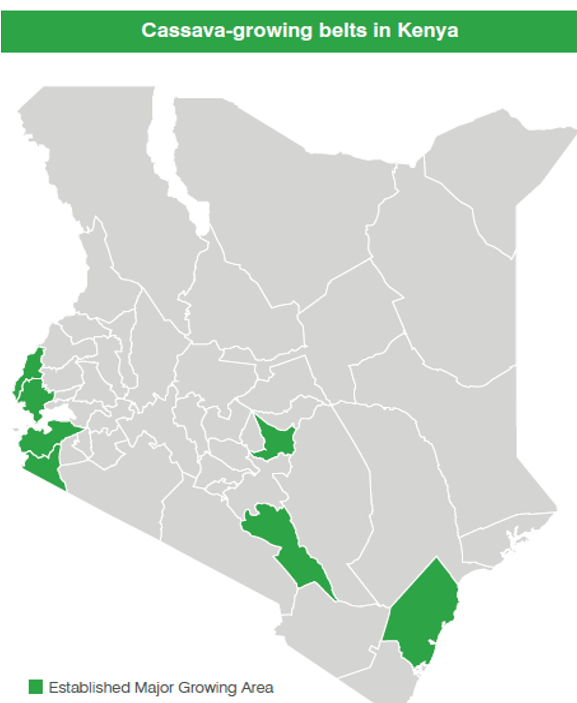
Cassava Variety MM95/0183
- Matures in 10-15 months.
- This is a mid-maturing, high/medium yielding cassava variety that is sweet tasting (low cyanide content).
- Rainfall 800-1200 annually.
- Altitude range of 800-1500 m.a.s.l.
- Soils well-drained sandy loam.
- Yields (t ha-1) 50-70.
Cassava Variety Katsuhanzala (990132)
- Matures in 8-10 months.
- Its root flesh colour is cream.
- Used for home consumption or industrial purposes.
- Wide adaptation from the coffee zone to the coastal region.
- Yields 36.7 t/ha.
- Resistance to stress.
- High yielding.
- High dry matter.
- Low in cyanogenic potential (HCN).
- Rainfall 500-1000 annually.
- Altitude range of 200-1500 m.a.s.l.
- Soils well-drained sandy loam.
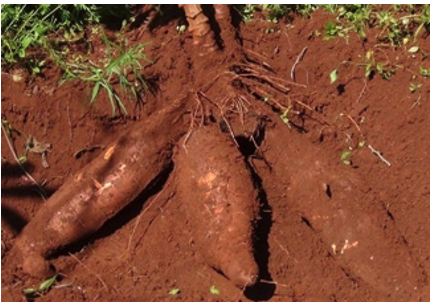
Katsuhanzala Tubers
Cassava Variety KME-3
- The variety is resistant to cassava mosaic disease, early maturing, has Low CNP and sweet, poundable.
- Its Root pulp colour is cream with dry matter of 29%.
- It grows in warm, semi-arid areas, 200-2000 m.a.s.l.
- Rainfall range of 500-1000 mm per year.
- Maturity 8-10 Months.
- Yields 40 t/ha.
- Tolerant to drought.
Cassava Variety Katune (990005)
- Matures in 8-10 months.
- Flesh colour is cream.
- Wide adaptation from the coffee zone to the coastal region.
- Yields 37.1 t/ha.
- Resistant to cassava mosaic disease.
- Rainfall 500-1000 annually.
- Altitude range of 200-1500 m.a.s.l.
- Soils well-drained sandy loam.
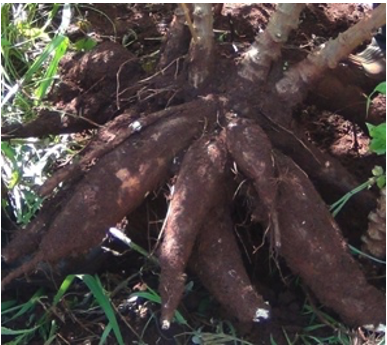
Katune Tubers
Cassava Variety KME-2
- The variety is resistant to cassava mosaic disease.
- Yields 45 t/ha.
- Matures between 8-10 months.
- Altitude between 200 – 2000 m.a.s.l.
- Rainfall of 500-1000 mm per year.
Cassava Variety Migyera
- Matures in 10-15 months.
- Yields 20 t/ha.
- Sweet/ low cyanide.
- Altitude 800-1750 m.a.s.l.
- Rainfall ranges 500-1200 mm per year.
Cassava Variety Shibe
- Straight stems ideal for intercropping.
- Mature between 8-12 months.
- Altitude 15-1200 m.a.s.l.
- Rainfall range of 500- 1000 mm per year.
- Yields 70.1 t/ha.
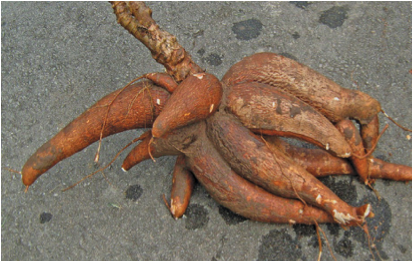
Shibe Tubers
Cassava Variety Tajirika
- Straight stems ideal for intercropping.
- Matures in 8 months.
- Altitude 15-1200 m.a.s.l.
- Rainfall of 500-1000 mm per year.
- Yields 63.3 t/ha.
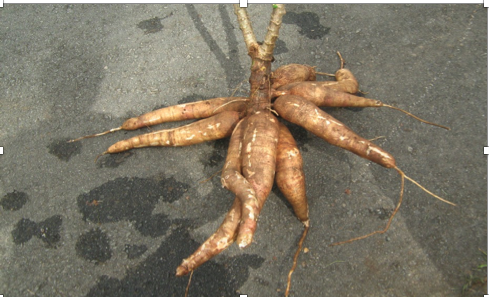
Tajirika Tubers
Cassava Variety Nzalauka
- Straight stems ideal for intercropping.
- Matures between 6-8 months.
- Altitude 15-1200 m.a.s.l.
- Rainfall amount of 500-1000 mm/year.
- Yields 52.9 t/ha.
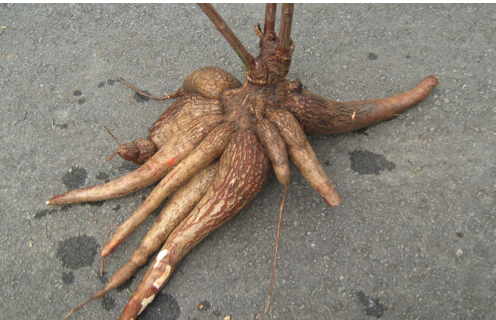
Nzalauka Tubers
Cassava Variety Siri
- High branching good for intercropping.
- Matures between 8-12 months.
- Altitude 15-1200 m.a.s.l.
- Rainfall, 400-100 mm/year.
- Yields 57.7 t/ha.
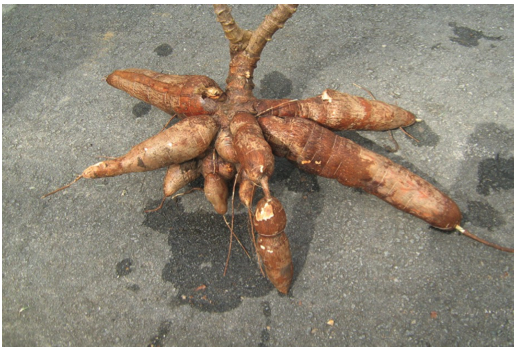
Siri Tubers
Cassava Variety Karibuni
- Short with open canopy.
- Matures in 8 months.
- Altitude 15-1200 m.a.s.l.
- Rainfall amount of 400-1000 mm per year.
- Yields 68.2 t/ha.
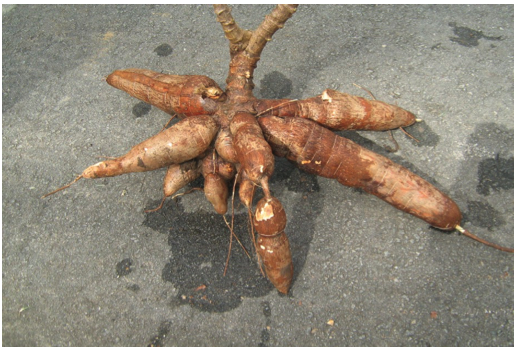
Karibuni Tubers
Cassava Variety Karembo
- Drought tolerant.
- Maturity 8-12 months.
- Rainfall 250-1300 mm per year.
- Altitude 15-1200 m.a.s.l.
- Yields 50-70 t/ha.
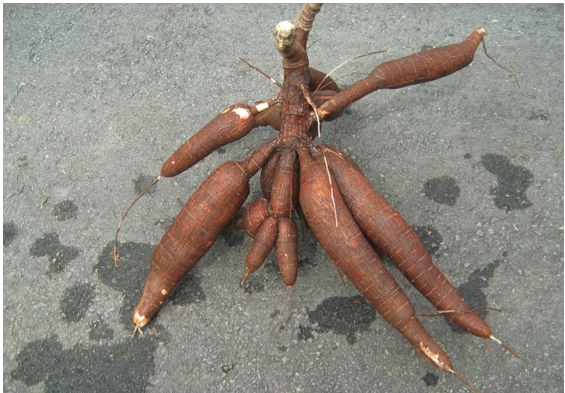
Karembo Tubers
Cassava Variety Guzo
- Rainfall 250-1300 mm per year.
- Altitude 10-700 m.a.s.l.
- Maturity 12-15 months.
- Yields 20-40 t/ha.
Cassava Variety Kibandameno
- Rainfall 250-1300 mm per year.
- Altitude 15-1200 m.a.s.l.
- Drought tolerant.
- Maturity 12-14 months.
- Yields 20-30 t/ha.
Cassava Variety KME1
- Rainfall 200-1000 mm per year.
- Altitude 250-1500 m.a.s.l.
- Drought tolerant.
- Maturity 12-14 months.
- Yields 20-25 t/ha.
Cassava Variety KME 4
- Rainfall 200-1000 mm per year.
- Altitude 250-1500 m.a.s.l.
- Drought tolerant.
- Maturity 8-10 months.
- Yields 30-40 t/ha.
Cassava Variety KME 61
- Rainfall 200-1000 mm per year
- Altitude 250-1500 m.a.s.l
- Drought tolerant.
- Tolerant to cassava mosaic virus and scales.
- Maturity 14-16 months.
- Yields 25-35 t/ha.
Cassava Variety Mucericeri
- Rainfall 200-1000 mm per year.
- Altitude 250-1750 m.a.s.l.
- Maturity 12-14 months.
- Yields 15-20 t/ha.
- Marginal areas with poor soils, and/or high risk of drought.
- Best adapted to well-drained loamy soils, light-textured, deep soils of intermediate fertility, low rainfall, and warm and moist climatic conditions
- Under high fertility conditions cassava top growth may be stimulated at the expense of root growth.
- Semi-arid conditions with rainfall as low as 500 mm per year.
- The selection of a suitable land for the cultivation of cassava is based on sandy clay loam that is well-drained without a fluctuating water table and no hardpan.
- Optimum soil pH is between 4.5 and 6.5.
- Cassava grows best in areas with a mean temperature of 25-29°C, and a soil temperature of about 30°C.
- Below 10°C the plant stops growing.
- Clear all bushes in the area to help remove the weeds and undergrowth which might otherwise compete with the growth of your cassava.
- Till the soil to loosen it, allow aeration and mix the soil with dried animal manure or compost to increase soil fertility.
- Tilling allows roots to penetrate more deeply and therefore cassava plants are established better.
- Prepare the land before rain on set or immediately after rain on set.
- Soil tillage can be mechanized using tractor-mounted ploughs or power tillers.
- Hand hoe or animal draft are also recommended.
- Prepare ridges or mounds.
Preparing Healthy Cassava Stems for Planting
- Obtain stems for planting from mature plants 10–12 months old.
- Store under the shade for 2–5 days (never more than 2 weeks) before cutting and planting.
- This makes the stems sprout faster than when they are planted freshly cut from the field.
- Stems should be stored vertically on the soil under a shade.
- The distal end of the stems should touch the soil, which is moistened regularly, with the surroundings kept free from weeds.
- Handle the stems with care not to destroy the nodes that may result in losses.
- Do not make sharp cut surfaces or keep stems in the open (leading to drying).
- Cut stems, with sharp tools, preferably secateurs or cutlasses, into 25-cm cuttings with 5–7 nodes.
Rapid Multiplication in a Nursery using 2-Node Cassava Stakes to Produce Large Quantities of Cassava Stems
- Rapid multiplication technique can be used to produce large quantities of cassava stems as planting materials for subsequent seasons.
- Select and use improved, healthy, and pest/disease free cassava stems.
- Cut the stems into several 2-node or 3-node stakes using secateurs, a sharp knife/machete, or a stake cutting machine.
- Step 1: Treat the stakes with available insecticides or fungicides by measuring out the quantities into a container, add water and mix thoroughly. For example, 1kg of Neem leaf powder in 5L of water. Put the stakes into the solution for 10 minutes.
- Step 2: Remove from the solution and place in perforated transparent polythene bags for pre-sprouting.
- Step 3: Store in the polythene bags under the shade of a tree or under the cassava canopy or in a farm shed for 7–10 days to sprout.
- Step 4: Prepare the nursery for planting.
- Step 5: Expose the polythene bags in the field by placing them on r i d g e s and mounds, or on the flat ground for 20 minutes.
- Step 6: Transplant the grown stakes into the nursery at 2–4 cm depth at a spacing of 100 cm × 50 cm or 50 cm × 50 cm in a well-prepared rapid multiplication field. Handle the stakes carefully to avoid breakage.
- Carefully select a cassava variety that you will grow.
- There are three methods of planting cassava:
- Horizontal method of planting cassava;
- Vertical method of planting cassava
- The inclined method of planting cassava
Horizontal Planting
- Plant cuttings are buried 5 – 10 cm below the soil surface in dry climates and when mechanical planting is used.
- Cuttings planted horizontally produce multiple stems and more tuberous roots but they are relatively smaller in size.
- However, in loamy and rich soils the multiple stems and roots are at an advantage resulting in high yields.
Vertical Planting
- Many people use this method during rainy days so that cuttings will not rot if the soil is constantly wet.
- In contrast, under low rainfall conditions, vertical planting may result in dehydration of the cuttings.
Inclined Planting
- Cuttings are inclined at 45o in semi-rainy areas, leaving 2-3 nodes above ground level.
- The inclination of the stem and roots provide leverage which makes harvesting easier than in the other orientations.
- Plant early in the morning or late afternoon when the sun is cool to prevent excess heat from heating the crop.
- Replace all cuttings which did not bud after two weeks of planting.

Cassava Stem Panted Vertically
- Use a contact and/or pre-emergent herbicide to control weeds for the first three months of growth.
- Apply post-emergence herbicides as soon as weeds begin to emerge after the pre-emergence herbicide treatment.
- Weed with hoes or adapted cutlasses 3 or more times depending on the type of weed.
- On a large scale, use tractor operated weeders
Water management methods for cassava production include:
- Terracing.
- Contour banks.
- Practice minimum tillage in sandy soils to conserve organic matter, and moisture, and to reduce soil erosion.
- In shallow or hard soils, make ridges or mounds to increase the topsoil volume per plant for a better establishment.
- Plant at the correct spacing.
- Plant at the right time. In general, cassava should be planted when 2 months of adequate soil moisture is expected after planting.
- Cassava/maize and cassava/legume intercrops have been found to make better use of the land, reduce soil erosion and the risk of crop loss.
- For sole crop cassava, plant on the top of the ridge or heap. When intercropped with maize, plant cassava on the top and maize on the side of the ridge or mound.
- Where cassava is grown as an intercrop, adjust the spacing from 0.8m × 1m to 1m × 1m to suit the branching habits of cassava and the other crop(s).
- Plant leguminous crops such as soybean in rotations or intercrops, or Mucuna in fallows. This helps to sustain soil fertility and quality, and to manage water, noxious weeds (spear grass), pests and diseases.
- Mulch cassava seedbeds: This means covering the soil surface with plant materials. It is especially valuable when growing cassava in dry areas and on slopes.
- Sources of good mulching material include dead leaves from alley crops, rice husks, coffee hulls, crop/weed residues and leguminous plants (live mulch).
- Use of chemical fertilizer.
- Use of organic inputs.
- Integrated soil fertility management.
Cassava Green Mites Pest Management
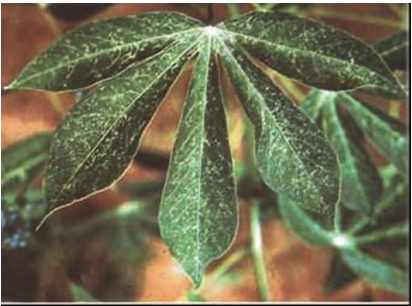
Key signs of Green Mites Pests
- Tiny greenish-yellowish spots.
- The leaves become mottled and die.
- The shoot tip looks like a ‘candle stick’.
Pest Management
- Use resistant varieties.
Cassava Scales

Key signs of Cassava Scales
- Scales are white in colour.
- Scales are mainly seen on the lower parts of the stems and also on the leaves.
- Dying of the cassava plant from the top.
Pest Management
- Improving soil fertility.
- Improving soil moisture.
Cassava Mealy Bugs
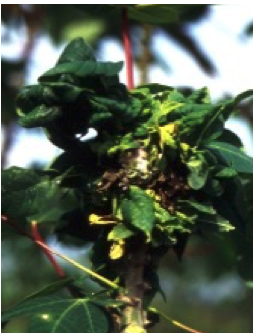
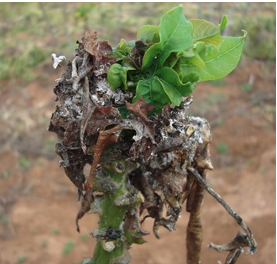
Key signs of Cassava Mealy bugs
- Smoky mold on the leaf surface due to mealy bug excrement.
- Leaf yellowing
- Defoliation beginning with basal leaves.
- Curling of leaves at the growing points.
- Short internodes.
- Little new leaf growth,
- Very young plants may dry up.
Pest Management
- Use of clean field
- Growing cassava varieties that are resistant to cassava mealy bug.
- Up root and burn affected plants.
Termites
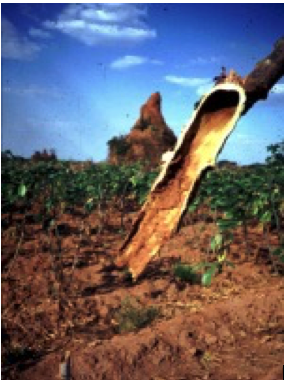
Key signs of Termites Damage
- Damaged cassava stems and storage roots.
- In newly planted cassava farms termites chew and eat stem cuttings.
Pest Management
- Use of insecticides like Aldrin, or granulated. Carbofuran, to be incorporated into soil directly under the cuttings.
Vertebrate Pests: Mole
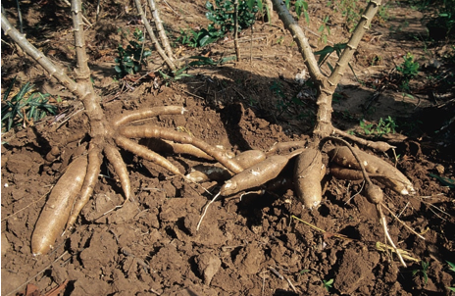
Key signs of mole Damage
- Cassava roots damaged at the end, leading to accelerated deterioration.
Mole Management
- Setting traps.
- Planting on mounds rather than ridges.
- Planting the deep rooted, poisonous shrub Tephrosia vogelii in the field.
Cassava Mosaic Disease Management
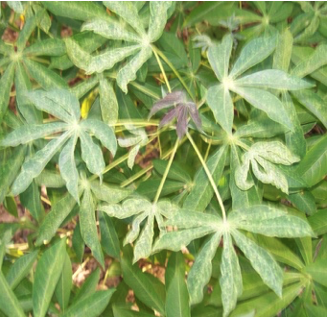
Key signs of Cassava Mosaic Disease
- Light green, yellow or white patches on the leaves.
- Wrinkling of leaves.
- Shrinking of leaves at the blade.
- Stunted plants.
- For cassava to reach maturity, it differs from one variety to another.
- Generally, cassava becomes mature for harvesting 8 – 18 months after planting.
- Moreover, radial cracking of the soil around the stem is an indicator of maturity.
- Use disease‐free cuttings.
- Plant early to avoid peak of whitefly vectors.
- Use resistant/tolerant varieties.
- Continuous field inspection to rogue out infected plants.
Cassava Brown Streak Disease Management
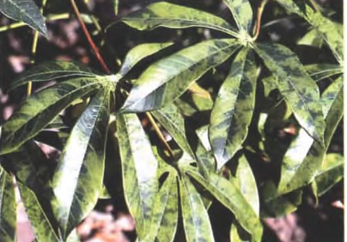
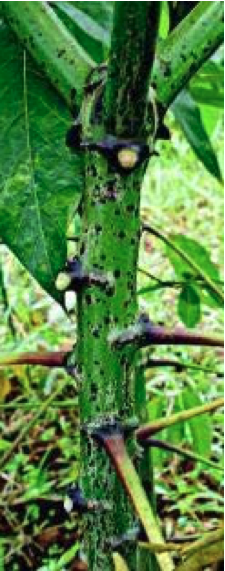
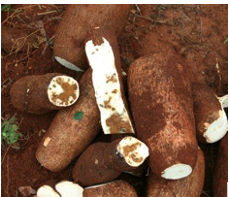
Key signs of Cassava Brown Streak Disease
- Yellowing of leaves.
- Black colouring of the stem bark.
- Brown colouring of the roots
Disease Management
- Use the cassava cuttings which are free from the cassava brown streak disease.
- Use tolerant/resistant varieties.
- Remove diseased plants from the field.
Cassava Anthracnose Disease Management
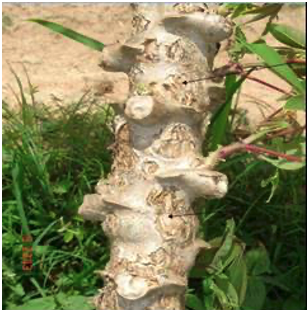
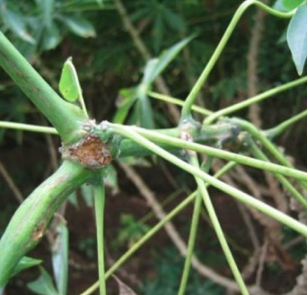
Key signs of Cassava Anthracnose Disease
- Initial symptoms of the disease are oval lesions ("sores") on young stems.
- On older stems, raised fibrous lesions develop, that eventually become sunken.
- Leaves drooping downwards.
- In severe cases wilting leaves which die and fall from plant leading to plant defoliation.
- Death of shoots;
- Soft parts of plant become twisted and distorted.
Disease Management
- Pruning of infected plant parts followed by burning.
- Destruction of plant remains after harvest.
- 2‐ 3 weeding from planting.
- Use resistant cassava variety.
- Use of fungicides to manage anthracnose disease.
Cassava Bud Necrosis Disease Management
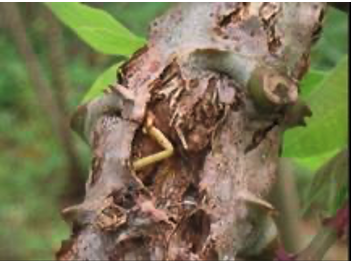
Key signs of Cassava Bud Necrosis Disease
- Dark or grey patches or marks on stem surfaces of cassava.
- The patches cover the buds on the stem hence, giving the disease its name.
Disease Management
- Use of healthy planting materials.
- Maintaining good planting distances.
Cassava Brown Leaf Spot
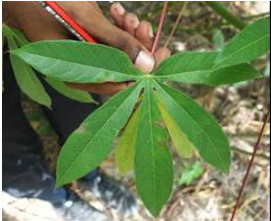
Key signs of Cassava Brown Leaf Spot
- Circular or irregular brown spots with darker margin between leaf veins on older leaves.
- If infection is severe, leaves may turn yellow, dry out and drop from the plant.
Disease Management
- Remove leaves and crop remains from around plants to prevent disease spreading.
- Remove weeds from around crop.
Cassava Bacterial Blight
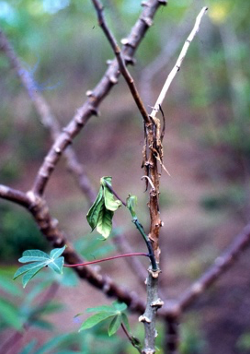
Key signs of Cassava Bacterial Blight
- Small, angular, brown, water-soaked lesions between leaf veins on lower surfaces of leaves.
- Leaf blades turning brown as lesion expands.
- Defoliation occurs with leaf petioles remaining in horizontal position as leaves drop.
- Dieback of shoots
- Brown gum may be present on stems, leaves and petioles.
- Harvest roots only when you have a ready market to sell your cassava tubers to prevent them from deterioration, leading to post-harvest waste.
Manual Harvesting
- This is the traditional method of harvesting cassava using indigenous tools such as hoe, cutlass, mattock, earth chisel.
- Manual harvesting requires about 22–62man days per hectare.
Semi-Manual Harvesters
- Depending on the soil type, semi-manual harvesters are used which adopt the lever principle to reduce human effort used in uprooting the cassava.
- Field capacity (man days per hectare): 6.2–19.5.
Mechanised Harvesters
- Harvesting cassava mechanically involves the use of a harvesting implement integrally hitched to a tractor to dig out the cassava roots.
- Field capacity (ha/hour): 0.25–0.38.
Preparing Fresh Cassava Roots for Storage
- Cutting off the stems, leaving only a short part above ground, done about three weeks prior to harvesting.
- Harvesting the roots with part of the stem (2-5 cm) still attached may prevent a rapid spread of decay into the root.
- Harvesting while the soil is wet, for example after a rain to minimize damage at lifting.
- Select roots that do not show signs of injury, that are to be kept for more than one week or more.
Indigenous Technology knowledge for Storing Fresh Cassava
- Leaving the roots in the ground until they are needed.
- Once harvested, to consume or process the roots immediately into a more durable form.
- Re-burying the roots in trenches covered with plant material and soil.
- Piling the roots in heaps and keeping them moist by watering them daily.
- Applying a thick coating of soft clay or mud.
- Keeping small quantities of cassava in water.
Improved Low-Cost Storage Methods for Fresh Cassava
- Storage in boxes lined with moist sawdust or wood shavings.
- Storage in plastic bags or plastic film wraps.
Improved Higher Cost Techniques
- Refrigeration.
- Deep freezing
- Waxing.
- Chemical treatments.
Peeling
- Mechanical peelers can peel between 600kg and 800k roots per hour.
- The Peelers remove 60-90% of the peels.
Size Reduction
- Size reduction is mostly by chipping, slicing, and grating.
- Chipping is used for making dried chips that could be milled to flour or for making animal feeds.
- Grating is widely used for making starch, flour, and some other products.
- Commercial mechanical chippers and graters could process 2-3 tons of fresh roots per hour.
Dewatering
- Mechanized single-screw, double-screw, hydraulic, and double basket presses have replaced the traditional methods.
Drying
- An improvement to this is the drying of cassava on raised platforms on black polythene sheet.
- For large scale processing, mechanical drying of cassava is the most suitable.
- Many types of mechanical cassava dryers are now available, these include cabinet, rotary, tunnel, solar, and flash dryers.
Milling
- Milling machines for grains and other crops are used for milling of cassava.
- Cassava for animal feed should be milled gritty.
Packaging and Storage
- Polythene bags.
- Paper or polypropylene bags lined with polythene.